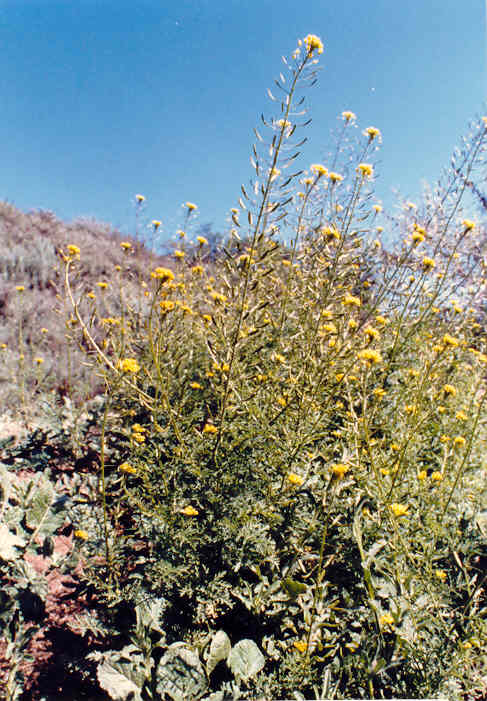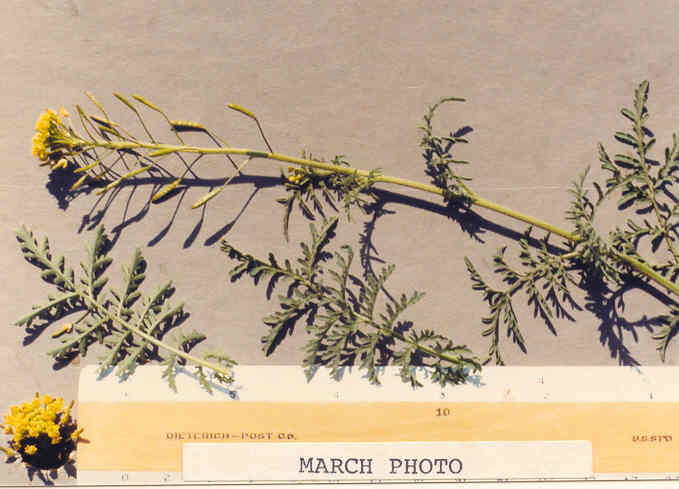
 |
Descurainia pinnata ssp. menziesii (DC). Detl
= Sisymbrium pinnatum ssp. menziesii
Brassicaceae (Mustard Family)
NativeTansy-MustardPepper Grass. |
Plant Characteristics:
Erect annual to 6 dm. high, not branched at base; herbage ashy
tomentulose (gray with soft or wooly hairs), sometimes glandular; lvs. 2-9 cm.
long, basal and lower cauline 2-3 pinnate with fine linear to oblanceolate
segments, hairs dense; upper lvs. 1-2 pinnate, lobes acute at tip, linear to
oblanceolate; pedicels divaricate-ascending, 7-14 mm. long; sepals mostly equal
to or exceeding the greenish yellow petals, 2-2.5 mm. long; siliques linear,
often curved, 1-3 cm. long, ca. 1 mm. thick, silique septum with 2-3
longitudinal nerves, loosely ascending; style very short; seeds 10-20 in each
cell, oblong-ellipsoid, ca. .8 mm. long.
Habitat: San Joaquin
Valley, south to the deserts and west to coastal S. Calif., below 2500 m.
March-June.
Name:
Named for F. Descurain, French botanist, (1658-1740). (Munz, Flora So. Calif.
286). Latin, pinnatus, plumed, with feathers, winged. Menziesii is for
Archibald Menzies (1754-1842).
Surgeon and naturalist to Vancouver's Pacific Coast expedition.
(Jaeger 198,313). The
species name probably refers to the fine segments of the pinnate leaves.
General:
Common in the study area and very common on the Castaway's Bluffs and
along the lower path near the Delhi Ditch.
(my comments). All of the species are edible, although
some are better than others. They
may be eaten as greens and the seeds may be parched, ground and eaten as mush or
used in other ways. The Mexicans
used the seeds in poultices for wounds. This
species is reported to be poisonous to livestock, but only when eaten in large
quantities over a long period of time. It
causes partial or complete blindness, accompanied by an inability to use the
tongue or to swallow. The seeds of
many of the wild mustards were used by the Indians.
They were gathered by knocking them into baskets, they were then parched
and ground for use in soup or mush. D.
pinnata is sold in Mexican drug stores as Pamito. The leaves can
be boiled or roasted and eaten, though several changes of water are necessary to
make them palatable. (Clarke
65,205). Pinole was a staple food widely used. It was a fine flour made by grinding chia, tansy mustard or
many of the grasses and annual flouring plants.
It was eaten dry or in some form of mush. The tiny, red seeds of tansy mustard were gathered by the
Indians and tossed in a tightly woven basket with hot coals until roasted, then
ground. The leaves were boiled or
roasted and enjoyed much as we like mustard greens. Tansy Mustard was used for stomach ills, especially for
children. (Bauer 54, 158 and a page
not recorded). The
ground seeds were used by the Cahuilla, Indians of the Colorado Desert the San
Jacinto and San Bernardino Mountains, to flavor soups or as a condiment with
corn. (Bean and Saubel 66).
About 20 species of temperate Eurasia and America.
(Munz, Flora So. Calif. 286).
D. pinnata has been found to
accumulate free nitrates in quantities capable of causing death or distress in
cattle. (Fuller 385).
In
Text Ref:
Bean & Saubel 66; Hickman, Ed. 414; Munz, Calif
Flora 233; Munz, Flora So. Calif. 286;
Robbins et al. 224; Roberts 16.
Photo Ref:
Feb 2 84 # 8; Feb 85 # 3A; Mar 85 # 17A; Feb 1 86 # 5,6.
Identity: by R. De Ruff, confirmed by F. Roberts.
Computer Ref:
Plant Data 7.
Have plant specimen.
Last edit 10/23/02.
 |